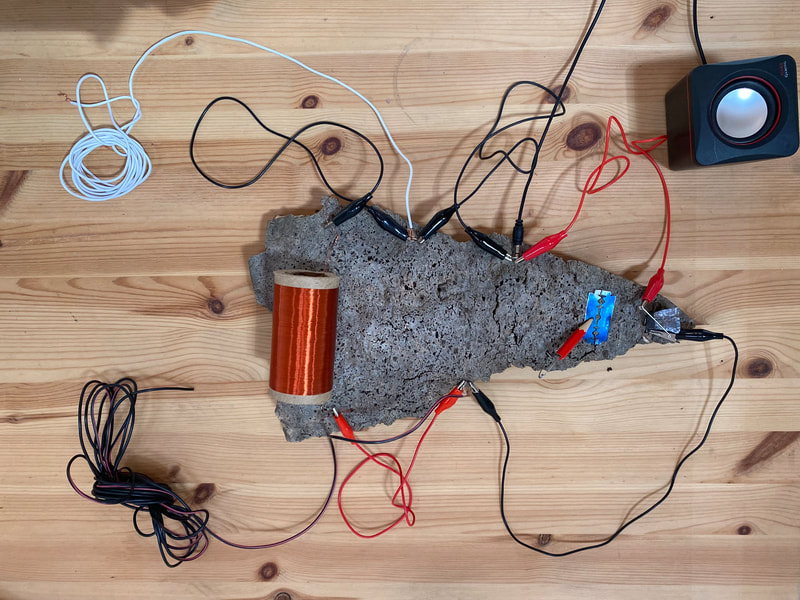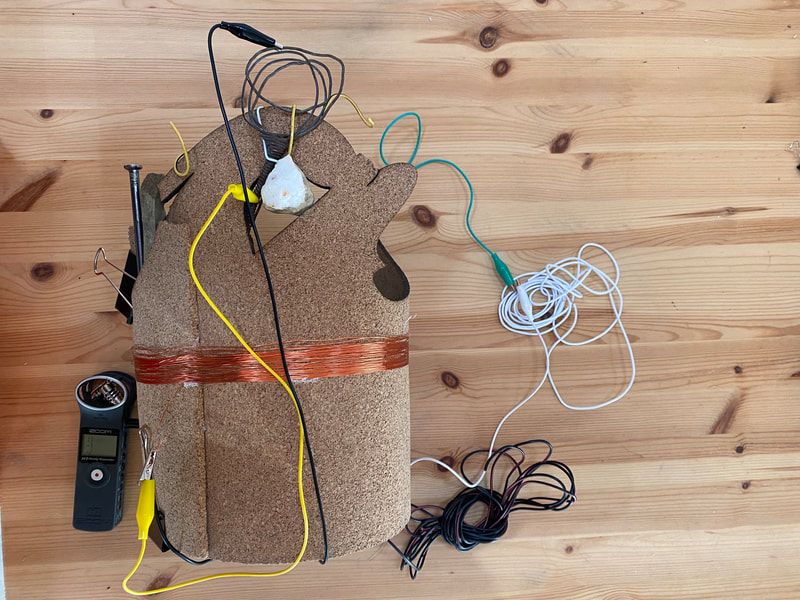Open Wave-Receiver
Developed during Buinho Creative Hub residency 2021 | Published in MAKE Magazine (Vol. 80) 2022 | Broadcast on Radiophrenia and Movement Radio 2022 | Shared in numerous workshops
'Open Wave-Receiver' is our design for a simple, low cost, no battery, radio receiever. Though initially based on foxhole radios and crystal sets prolifering in the 1940s, we think of our work with the circuit more as a reinterpretation, a reclamation, an intentional moving away from roots entangled with the military, and the singular (national) subject, from which much radio technology stems.
We have replaced parts of the circuit with household objects, more easily accessible and providing intriguing results. Our re-naming of this device as an ‘Open Wave-Receiver’ shows how we want to think and engage with these simple circuits differently. Firstly, it is a design that doesn’t have a tuner, it is open to a broad range of multiple frequencies received simultaneously. Secondly, it is adaptable and forgiving: the circuit is open to having parts switched out for alternatives, pieces can be sculptural, and it can be literally built into a location. Thirdly, our research and experiments are to be shared, to be further experimented by and with others, to be in-process. So we mean “open” as in open access; open as in untunable; open to the elements, unhoused; open to different parts; open for experimentation.
Our first experiments with the Open Wave-Receiver took place during a residency at Buinho Creative Hub (PT). Our working design was tested during a public workshop in Messejana. Participants became co-investigators as we worked together to test materials and designs. Amongst those, participants experimented by:
- Building the radio on cork bark, local to the area, and using this as a base-board - Anaïs Schendekehl
- Introducing a rock at the centre of the coil, altering its usual air-core properties - Carlos Alcobia
- Creating a wearable radio in the shape of a hat, for a more portable experience - Brigitte Hart
To extend the reach our experiments-in/with-public, we contributed a 'how-to' guide, published in Make Magazine in print (Vol 80) and online, documenting all of the making steps in photos and easy-to-follow instructions. This publication led to many contacts across Europe and North America, and has continued to perpetuate both listening practices and involvement in radio-listening throughout the Maker, radio and DIY communities.
Alongside this, we produced two audio versions of the 'how-to' guide, weaving transmission recordings captured with Open Wave-Receivers with a sonic make-a-long. We also riso-print batches of zines, that describe our ethos for listening alongside diagrams for making.
Alongside this, we produced two audio versions of the 'how-to' guide, weaving transmission recordings captured with Open Wave-Receivers with a sonic make-a-long. We also riso-print batches of zines, that describe our ethos for listening alongside diagrams for making.
These resources have travelled, extending like tentacles into nooks of educational establishments, artist co-ops, festivals and community spaces, and we've delivered countless workshops over the past three years across Europe and via fragile video links in Northern and Latin America. As invitations to facilitate making workshops continue, we keep an open channel as to our learning from this participatory research process. Open Wave-Receievers often travel with us on personal adventures, and we excitedly text 'field notes' describing the locations, bodies and materials that may be influencing radio reception. We are excited to hear also from past workshop participants, who extend their own devices and report back on their listenings. Tinja Ruusuvuori, participant at a 2023 workshop in the Pyrenees (FR), recently sent us news of experiments attaching her antenna to a kite.





